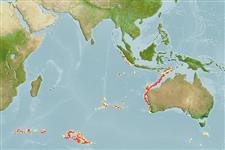>
Gadiformes (Cods) >
Macrouridae (Grenadiers or rattails)
Etymology: Nezumia: A Japanese word that means "mouse" .
More on authors: Iwamoto & Williams.
Environment: milieu / climate zone / depth range / distribution range
Ecología
marino batidemersal; rango de profundidad 500 - 1320 m (Ref. 35909). Deep-water
Eastern Indian Ocean: Western Australia.
Tamaño / Peso / Age
Maturity: Lm ? range ? - ? cm
Max length : 37.0 cm TL macho / no sexado; (Ref. 35909)
Short description
Morfología | Morfometría
Espinas dorsales (total): 2. Pelvic fin rays 11-12; height first dorsal fin about equal to or more than head length; underside of head scaled, but lacking prominent pores of sensory lateralis system; body scales with dense covering of broadly shield-shaped spinules; 5.5-7.5 scale rows below origin of second dorsal fin, 36-42 lateral line scales over distance equal to predorsal length; trunk completely encircled by broad dark band, although sometimes rather faint; first dorsal fin uniformly blackish; anterior dermal window of light organ scarcely developed, usually apparent only as triangular anterior protrusion of naked periproct, situated behind line connecting insertions of pelvic fins; orbit to preopercle distance 38-44% of head length; upper jaw 29-34%; gill rakers on inner side of first arch 9-10. Snout protruding, angular.
A benthic species found on the continental slope (Ref. 75154).
Life cycle and mating behavior
Madurez | Reproducción | Puesta | Huevos | Fecundidad | Larva
Iwamoto, T. and A. Williams, 1999. Grenadiers (Pisces, Gadiformes) from the continental slope of western and northwestern Australia. Proc. Calif. Acad. Sci. 51(3):105-243. (Ref. 35909)
IUCN Red List Status (Ref. 130435)
Threat to humans
Harmless
Human uses
Más información
Nombres comunesSinónimosMetabolismoDespredadoresEcotoxicologíaReproducciónMadurezPuestaAgregación para la puestaFecundidadHuevosEgg development
Age/SizeCrecimientoLength-weightLength-lengthLength-frequenciesMorfometríaMorfologíaLarvaDinámica larvariaReclutamientoAbundanciaBRUVS
ReferenciasAcuiculturaPerfil de acuiculturaRazasGenéticaElectrophoresesheritabilidadEnfermedadesProcesamientoNutrientsMass conversion
ColaboradoresImágenesStamps, Coins Misc.SonidosCiguateraVelocidadTipo de nataciónSuperficie branquialOtolitosCerebrosVisión
Herramientas
Special reports
Download XML
Fuentes de Internet
Estimates based on models
Preferred temperature (Ref.
123201): 1.9 - 8.3, mean 5.9 °C (based on 60 cells).
Phylogenetic diversity index (Ref.
82804): PD
50 = 0.5000 [Uniqueness, from 0.5 = low to 2.0 = high].
Bayesian length-weight: a=0.00219 (0.00111 - 0.00431), b=3.20 (3.03 - 3.37), in cm total length, based on LWR estimates for this (Sub)family-body shape (Ref.
93245).
Nivel trófico (Ref.
69278): 3.3 ±0.1 se; based on size and trophs of closest relatives
Resiliencia (Ref.
120179): Bajo, población duplicada en un tiempo mínimo de 4.5-14 años (Preliminary K or Fecundity.).
Fishing Vulnerability (Ref.
59153): Low to moderate vulnerability (27 of 100).
